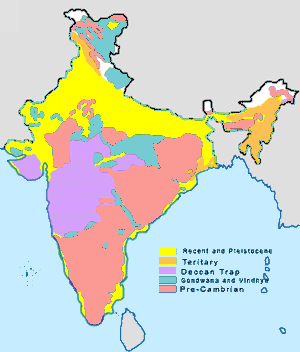Geology of India
Geology of India
The geology of India is diverse and can be divided into several regions based on geological formations. These regions include the Himalayan region, the Indo-Gangetic Plain, the Peninsular Plateau, the Thar Desert, and the Coastal Plains. Each of these regions has distinct geological features and history.
Geological Regions[edit | edit source]
Himalayan Region[edit | edit source]
The Himalayan region is characterized by the presence of the Himalayas, which are the result of the collision between the Indian Plate and the Eurasian Plate. This region is known for its complex geological structures, including fold mountains, thrust faults, and metamorphic rocks.
Indo-Gangetic Plain[edit | edit source]
The Indo-Gangetic Plain is a large alluvial plain that lies between the Himalayas and the Peninsular Plateau. It is primarily composed of sediments deposited by the Ganges, Indus, and Brahmaputra rivers. This region is known for its fertile soil and extensive agricultural activities.
Peninsular Plateau[edit | edit source]
The Peninsular Plateau is one of the oldest and most stable landmasses in India. It is composed of ancient igneous and metamorphic rocks and is divided into several smaller plateaus, including the Deccan Plateau, the Chotanagpur Plateau, and the Malwa Plateau. The region is rich in mineral resources such as iron ore, coal, and manganese.
Thar Desert[edit | edit source]
The Thar Desert, also known as the Great Indian Desert, is located in the northwestern part of India. It is characterized by arid conditions, sand dunes, and sparse vegetation. The geology of this region includes aeolian deposits and fossil evidence of ancient river systems.
Coastal Plains[edit | edit source]
The Coastal Plains of India are divided into the Western Coastal Plain and the Eastern Coastal Plain. These plains are characterized by their proximity to the Arabian Sea and the Bay of Bengal, respectively. They are composed of recent alluvial deposits and are known for their rich biodiversity and fertile lands.
Geological History[edit | edit source]
India's geological history dates back to the Precambrian era, with some of the oldest rocks in the world found in the Peninsular Plateau. The region has undergone several geological processes, including volcanism, sedimentation, and metamorphism. The collision of the Indian Plate with the Eurasian Plate around 50 million years ago led to the formation of the Himalayas and significantly influenced the geology of the region.
Mineral Resources[edit | edit source]
India is rich in mineral resources, including coal, iron ore, bauxite, manganese, and mica. The Peninsular Plateau is particularly known for its mineral wealth. The country also has significant reserves of limestone, copper, and gold.
Related Pages[edit | edit source]
- Himalayas
- Indian Plate
- Deccan Plateau
- Thar Desert
- Indo-Gangetic Plain
- Western Coastal Plain
- Eastern Coastal Plain
Categories[edit | edit source]
Search WikiMD
Ad.Tired of being Overweight? Try W8MD's NYC physician weight loss.
Semaglutide (Ozempic / Wegovy and Tirzepatide (Mounjaro / Zepbound) available. Call 718 946 5500.
Advertise on WikiMD
|
WikiMD's Wellness Encyclopedia |
| Let Food Be Thy Medicine Medicine Thy Food - Hippocrates |
Translate this page: - East Asian
中文,
日本,
한국어,
South Asian
हिन्दी,
தமிழ்,
తెలుగు,
Urdu,
ಕನ್ನಡ,
Southeast Asian
Indonesian,
Vietnamese,
Thai,
မြန်မာဘာသာ,
বাংলা
European
español,
Deutsch,
français,
Greek,
português do Brasil,
polski,
română,
русский,
Nederlands,
norsk,
svenska,
suomi,
Italian
Middle Eastern & African
عربى,
Turkish,
Persian,
Hebrew,
Afrikaans,
isiZulu,
Kiswahili,
Other
Bulgarian,
Hungarian,
Czech,
Swedish,
മലയാളം,
मराठी,
ਪੰਜਾਬੀ,
ગુજરાતી,
Portuguese,
Ukrainian
Medical Disclaimer: WikiMD is not a substitute for professional medical advice. The information on WikiMD is provided as an information resource only, may be incorrect, outdated or misleading, and is not to be used or relied on for any diagnostic or treatment purposes. Please consult your health care provider before making any healthcare decisions or for guidance about a specific medical condition. WikiMD expressly disclaims responsibility, and shall have no liability, for any damages, loss, injury, or liability whatsoever suffered as a result of your reliance on the information contained in this site. By visiting this site you agree to the foregoing terms and conditions, which may from time to time be changed or supplemented by WikiMD. If you do not agree to the foregoing terms and conditions, you should not enter or use this site. See full disclaimer.
Credits:Most images are courtesy of Wikimedia commons, and templates, categories Wikipedia, licensed under CC BY SA or similar.
Contributors: Prab R. Tumpati, MD





